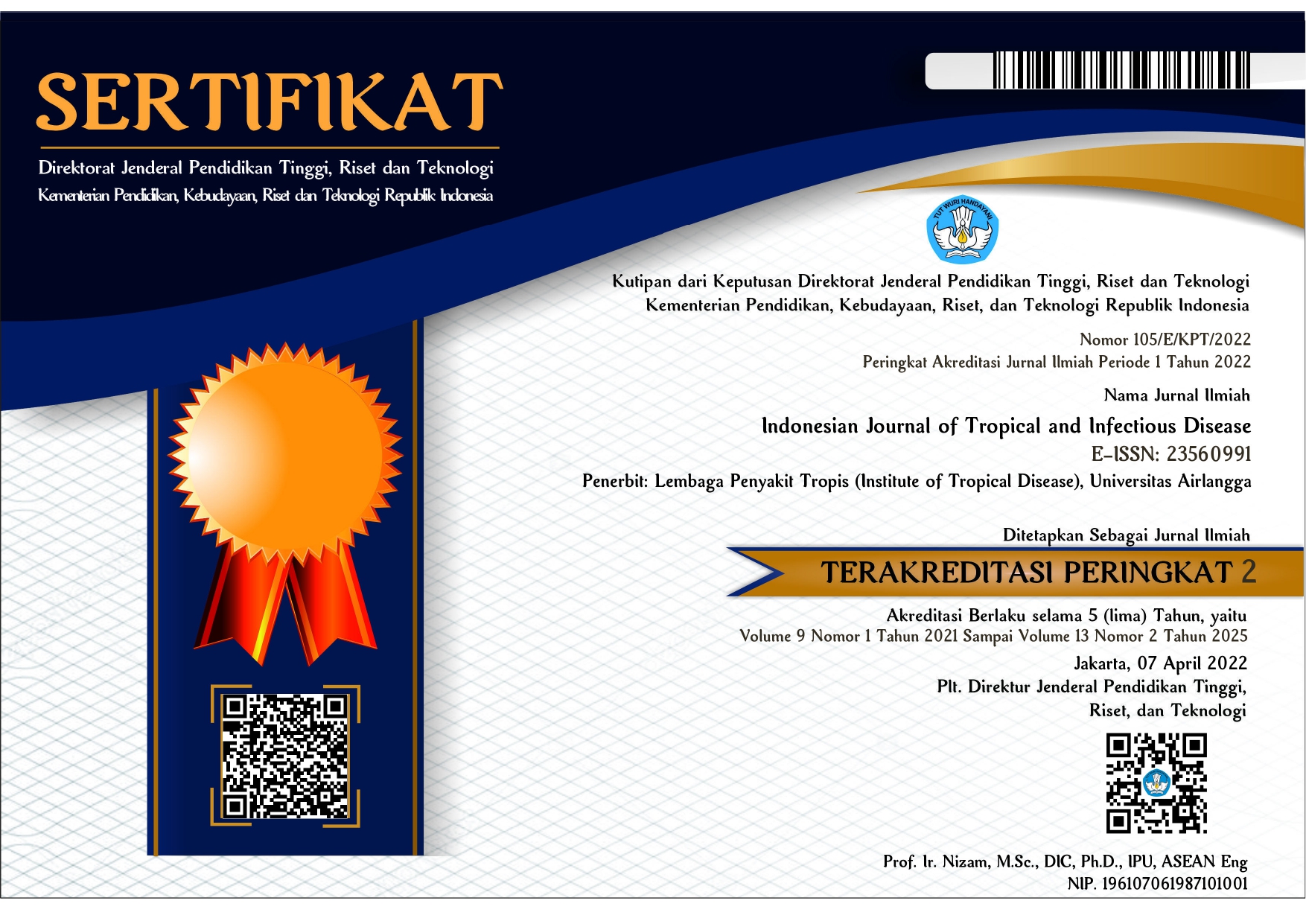Correlation between Probable or Non-Probable Leptospirosis with Laboratory Findings: Based on Leptospirosis Case Definition and Faine Criteria
Downloads
The incidence of leptospirosis is increasing globally, and developing countries are no exception. Leptospirosis cases are called the tip of the iceberg phenomenon, even though misdiagnosis, underdiagnosis, and underreporting still occur in health services. Thus, it leads to delays in leptospirosis treatment and may result in increased mortality rate from severe leptospirosis infection (Weil's disease). This study was to establish an accurate diagnosis by optimizing the Faine criteria. This study used an analytical observational design with a cross-sectional approach to examine faine criteria and laboratory examinations. We collected data from medical records from the Karanganyar General Hospital and the PKU Muhammadiyah Surakarta Hospital. We processed the data using SPSS version 25. The total number of samples was 42. They were divided into women (19%) and men (81%). Based on the definition category of leptospirosis cases, there were 2.4% probable group (score criteria faine part A 20-25) and 97.6% not-probable group (score criteria faine part A <20). Bivariate analysis (Chi-Square test) showed that there was no significant correlation between Faine Part A criteria and serological tests in both groups (p=0.874) as well as Hb (p=0.522), thrombocytopenia (p=0.265), leukocytosis (p=0.197), and neutrophilia (p=0.710). Loss of sodium and potassium didn’t show significant data (hyponatremia p=0.174; hypokalemia p=0.311; hypocalcemia p=0.131) not as in tropical diseases. The approach to diagnosis of leptospirosis cannot be performed using only Part A criteria, Faine, even though the patient was included in the probable definition category, even though the Faine Part A criteria score is 20-25 or ≥26.
Zein U. Leptospirosis. In: Setiati S, editor. Buku Ajar Ilmu Penyakit Dalam. VI. Jakarta: InternaPublishing; 2017. p. 633–8.
Wang S, Gallagher MAS, Dunn N. Leptospirosis [Internet]. StatPearls Publishing. 2022. Available from: https://www.ncbi.nlm.nih.gov/books/NBK441858/#article-24195.s8
Husni SH, Martini M, Suhartono S. Risk Factors Affecting the Incidence of Leptospirosis in Indonesia: Literature Review. 2023;VIII(1).
Wulandari E. Leptospirosis prevention and control in Indonesia. WHO Int. 2020;
Gasem MH, Hadi U, Alisjahbana B, Tjitra E, Hapsari MMDEAH, Lestari ES, et al. Leptospirosis in Indonesia: Diagnostic challenges associated with atypical clinical manifestations and limited laboratory capacity. BMC Infect Dis. 2020 Feb 27;20(1).
Rajapakse S. Leptospirosis: Clinical aspects. Clinical Medicine, Journal of the Royal College of Physicians of London. 2022;22(1):14–7.
Sukma FA, Mulida M, Sujana KS. Severe Leptospirosis: A Case Report [Internet]. Vol. 48. 2021 [cited 2025 Jun 6]. Available from: https://cdkjournal.com/index.php/cdk/article/view/148/131
Philip N, Affendy NB, Masri SN, Muhamad YY, Than LTL, Sekawi Z, et al. Combined PCR and MAT improves the early diagnosis of the biphasic illness leptospirosis. PLoS One. 2020 Sep 1;15(9 September).
Bandara K, Weerasekera MM, Gunasekara C, Ranasinghe N, Marasinghe C, Fernando N. Utility of modified Faine’s criteria in diagnosis of leptospirosis. BMC Infect Dis. 2016 Aug 24;16(1).
Handayani FD, Ristiyanto, Rahardiningtyas ASJE, Mulyono A, Bagus D. Buku Leptospirosis. 2019. 1–3 p.
Nusca A, Tuccinardi D, Pieralice S, Giannone S, Carpenito M, Monte L, et al. Platelet Effects of Anti-diabetic Therapies: New Perspectives in the Management of Patients with Diabetes and Cardiovascular Disease. Vol. 12, Frontiers in Pharmacology. Frontiers Media S.A.; 2021.
Modi D, Chowdhury SR, Mahamad S, Modi H, Cines DB, Neunert CE, et al. Primary versus Secondary Immune Thrombocytopenia (ITP): A Meeting Report from the 2023 McMaster ITP Summit. In: Thrombosis and Haemostasis. Georg Thieme Verlag; 2025.
He T, Kaplan S, Kamboj M, Tang YW. Laboratory Diagnosis of Central Nervous System Infection. Vol. 18, Current Infectious Disease Reports. Current Medicine Group LLC 1; 2016.
Kowalski S, Goniewicz K, Moskal A, Al-Wathinani AM, Goniewicz M. Symptoms in Hypertensive Patients Presented to the Emergency Medical Service: A ComprehensiveRetrospective Analysis in Clinical
Settings. J Clin Med. 2023 Sep 1;12(17).
Faqihudin FR, Puspitasari M, Jatmitko SW, Dewi LM. Correlation of Platelet Count, PDW, and MPV with Length of Stay in Children with Dengue Infection.
Ndako JA, Dojumo VT, Akinwumi JA, Fajobi VO, Owolabi AO, Olatinsu O. Changes in some haematological parameters in typhoid fever patients attending Landmark University Medical Center, Omuaran-Nigeria. Heliyon. 2020 May 1;6(5).
Tahlan A, Bhattacharya A. Haematological profile of dengue fever. Int J Res Med Sci. 2017 Nov 25;5(12):5367.
Wahyu Jatmiko S, Safari Wahyu Jatmiko dr, SiMed M. THE CORRELATION BETWEEN AGE WITH HEMATOCRIT, LEUKOCYTE, AND PLATELETS COUNTS OF DENGUE VIRUS INFECTION PATIENTS. Vol. 10. 2018.
Chacko CS, Lakshmi S S, Jayakumar A, Binu SL, Pant RD, Giri A, et al. A short review on leptospirosis: Clinical manifestations, diagnosis and treatment. Clin Epidemiol Glob Health. 2021 Jul;11:100741.
Galan DI, Roess AA, Pereira SVC, Schneider MC. Epidemiology of human leptospirosis in urban and rural areas of Brazil, 2000-2015 Vol. 16, PLoS ONE. Public Library of Science; 2021.
Browne ES, Pereira M, Barreto A, Zeppelini CG, de Oliveira D, Costa F. Prevalence of human leptospirosis in the Americas: a systematic review and metaanalysis. Vol. 47, Revista Panamericana de Salud Publica/Pan American Journal of Public Health. Pan American Health Organization; 2023.
Kumar D, Prasad ML, Kumar M, Munda SS, . V. An Insight Into Various Manifestations of Leptospirosis: A Unique Case Series From a State in Eastern India. Cureus. 2024 Mar 24;
Rodríguez-Rodriguez VC, Castro AM, Soto-Florez R, UrangoGallego L, Calderón-Rangel A, Agudelo-Flórez P, et al. Evaluation of Serological Tests for Different Disease Stages of Leptospirosis Infection in Humans. Trop Med Infect Dis. 2024 Nov 1;9(11).
Agampodi SB, Dahanayaka NJ, Nöckler K, Anne MS, Vinetz JM. Redefining gold standard testing for diagnosing leptospirosis: Further evidence from a well-characterized, flood-related outbreak in Sri Lanka. American Journal of Tropical Medicine and Hygiene. 2016 Sep 1;95(3):531–6.
Pinto GV, Senthilkumar K, Rai P, Kabekkodu SP, Karunasagar I, Kumar BK. Current methods for the diagnosis of leptospirosis: Issues and challenges. J Microbiol Methods [Internet]. 2022;195:106438. Available from: https://www.sciencedirect.com/science/article/pii/S0167701222000331
Budiman M, Putri SM, Rachmayanti PM, Kasmir R, Widiyanti D. STUDY OF RISK FACTORS AND LEPTOSPIRA DETECTION OF SANITARY WORKERS IN JAKARTA, INDONESIA. Biomedika. 2022 Sep 21;14(2):118–26.
Becirovic A, Numanovic F, DzaficF, Piljic D. Analysis of Clinical and Laboratory Characteristics of Patients with Leptospirosis in Fiveyear Period. Mater Sociomed. 2020;32(1):15–9.
Adiga DSA, Mittal S, Venugopal H, Mittal S. Serial changes in complete blood counts in patients with leptospirosis: Our experience. Journal of Clinical and Diagnostic Research. 2017 May 1;11(5):EC21–4.
Haake DA, Levett PN. Leptospirosis in Human. Vol. 25, Curr Top Microbiol Immunol. 2015. 169–172 p.
Petakh P, Isevych V, Kamyshnyi A, Oksenych V. Weil’s Disease—Immunopathogenesis, Multiple Organ Failure, and Potential Role
of Gut Microbiota. Vol. 12, Biomolecules. MDPI; 2022.
Fish-Low CY, Balami AD, Than LTL, Ling KH, Mohd Taib N, Md. Shah A, et al. Hypocalcemia, hypochloremia, and eosinopenia as clinical predictors of leptospirosis: A retrospective study. J Infect Public Health. 2020 Feb 1;13(2):216–20.
Gonçalves-de-Albuquerque CF, Cunha CMC da, Castro LVG de, Martins C de A, Barnese MRC, Burth P, et al. Cellular Pathophysiology of Leptospirosis: Role of Na/K-ATPase. Vol. 11, Microorganisms. Multidisciplinary Digital Publishing Institute (MDPI); 2023.
Chou LF, Yang HY, Hung CC, Tian YC, Hsu SH, Yang CW. Leptospirosis kidney disease: Evolution from acute to chronic kidney disease. Vol. 46, Biomedical Journal. Elsevier B.V.; 2023.
Copyright (c) 2025 Indonesian Journal of Tropical and Infectious Disease

This work is licensed under a Creative Commons Attribution-NonCommercial-ShareAlike 4.0 International License.
The Indonesian Journal of Tropical and Infectious Disease (IJTID) is a scientific peer-reviewed journal freely available to be accessed, downloaded, and used for research. All articles published in the IJTID are licensed under the Creative Commons Attribution-NonCommercial-ShareAlike 4.0 International License, which is under the following terms:
Attribution ” You must give appropriate credit, link to the license, and indicate if changes were made. You may do so reasonably, but not in any way that suggests the licensor endorses you or your use.
NonCommercial ” You may not use the material for commercial purposes.
ShareAlike ” If you remix, transform, or build upon the material, you must distribute your contributions under the same license as the original.
No additional restrictions ” You may not apply legal terms or technological measures that legally restrict others from doing anything the license permits.























